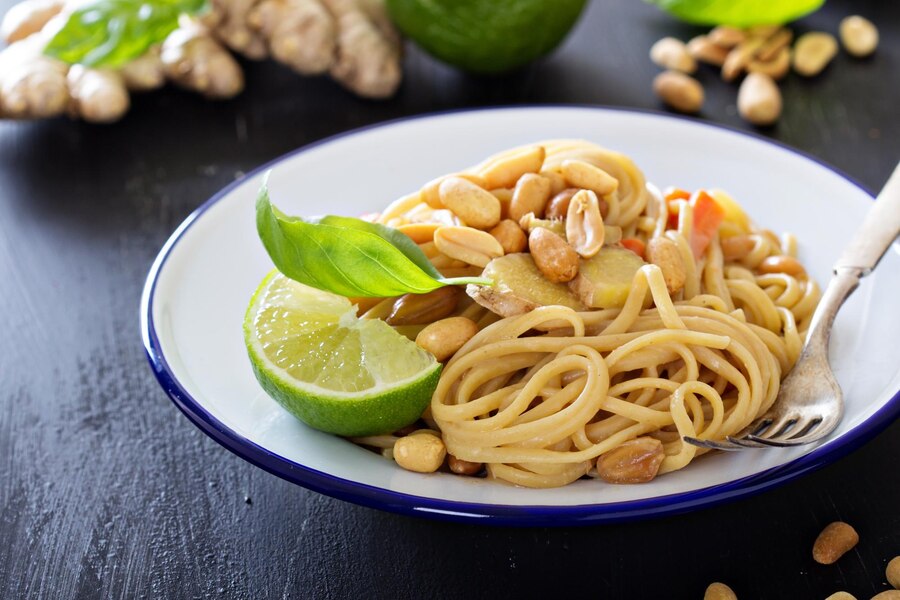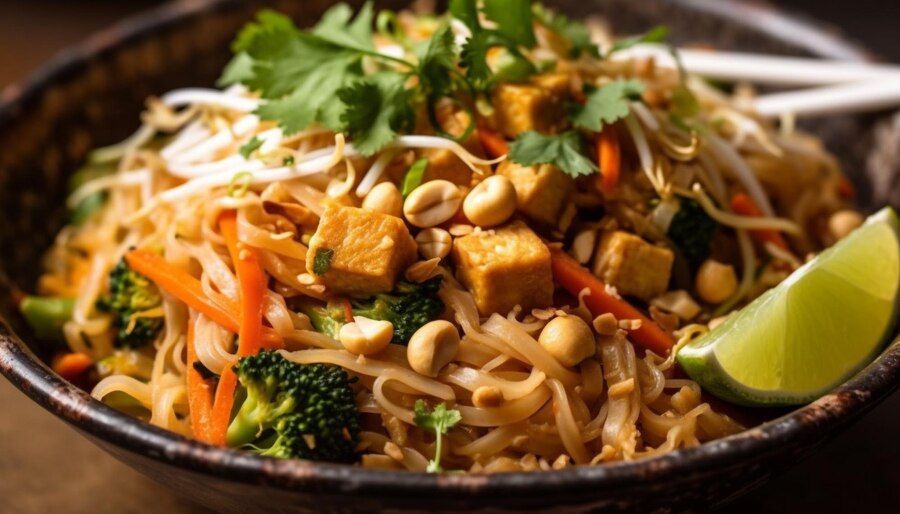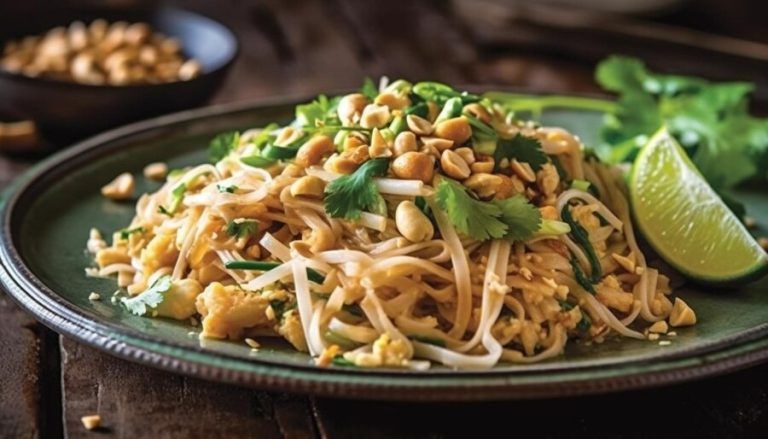Craving a burst of flavor? Look no further than this easy vegan Thai peanut noodles recipe. This dish delivers all the vibrant flavors of traditional Thai cuisine – tangy, sweet, and savory – without any animal products. Made with a simple yet flavorful Vegan Thai peanut sauce, this recipe is a quick and easy weeknight meal that’s both satisfying and healthy.
Ready to ditch the takeout and experience the magic of homemade vegan Thai peanut noodles? This recipe is perfect for beginners and seasoned cooks alike. You’ll learn how to create a vegan peanut sauce that rivals any restaurant, and discover the secrets to perfectly cooked noodles. So, gather your ingredients and get ready to savor the authentic flavors of Thailand in the comfort of your own kitchen.
Ingredients
- Noodles:
- 200 grams rice noodles (wide or thin)
- Vegetables:
- 1 cup julienned carrots
- 1 cup julienned bell peppers (red, yellow, or green)
- 1 cup shredded cabbage
- 1 cup broccoli florets
- 1/2 cup edamame (optional)
- 2 green onions, sliced
- Fresh cilantro for garnish
- Peanut Sauce:
- 1/2 cup creamy peanut butter
- 1/4 cup soy sauce (or tamari for gluten-free)
- 2 tbsp fresh lime juice
- 2 tbsp maple syrup or agave nectar
- 1 tbsp rice vinegar
- 1 tbsp sesame oil
- 1-2 cloves garlic, minced
- 1 tsp grated ginger
- 1-2 tbsp water (to adjust consistency)
- Toppings:
- Crushed peanuts
- Lime wedges
- Sesame seeds
Preparation Time: 20 minutes
Cooking Time: 15 minutes
Total Time: 35 minutes
Servings: 4
Estimated Cost: $25 (prices can vary depending on the brand, store, and location)
Step 1: Cook the Noodles
Prepare the rice noodles according to the package instructions. Once cooked, drain and rinse them under cold water to stop the cooking process and prevent them from sticking together. Set aside.
Step 2: Prepare the Vegetables
While the noodles are cooking, julienne the carrots and bell peppers, shred the cabbage, and cut the broccoli into small florets. Slice the green onions and set all vegetables aside.
Step 3: Make the Peanut Sauce
In a medium mixing bowl, combine the peanut butter, soy sauce, lime juice, maple syrup, rice vinegar, sesame oil, minced garlic, and grated ginger. Mix until smooth. If the sauce is too thick, add 1-2 tablespoons of water to achieve your desired consistency.
Step 4: Stir-Fry the Vegetables
In a large pan or wok, heat a bit of sesame oil over medium-high heat. Add the carrots, bell peppers, cabbage, and broccoli. Stir-fry for about 5-7 minutes until the vegetables are tender-crisp. Add the edamame and green onions, and cook for an additional 2 minutes.
Step 5: Combine Noodles and Sauce
Add the cooked noodles to the pan with the vegetables. Pour the peanut sauce over the noodles and vegetables, and toss to coat everything evenly. Continue to cook for another 2-3 minutes until the noodles and vegetables are heated through.
Step 6: Serve and Garnish
Serve the Vegan Thai Peanut Noodles hot, garnished with fresh cilantro, crushed peanuts, sesame seeds, and lime wedges on the side.
Enjoy your flavorful and satisfying Vegan Thai Peanut Noodles!
Storage and Reheating Instructions
For Storage: Allow the leftover Vegan Thai Peanut Noodles to cool to room temperature before storing them. This helps prevent condensation and sogginess. Transfer the noodles to airtight containers. It’s best to store the noodles and peanut sauce separately if possible, to maintain the best texture. Store the containers in the refrigerator. Properly stored, the leftovers can last for up to 3-4 days.
Reheating Methods
- Microwave: Place the desired portion of noodles in a microwave-safe dish. Lightly cover the dish with a microwave-safe lid or a damp paper towel to retain moisture. Microwave on high for 1-2 minutes, stirring halfway through. Make sure the noodles are heated evenly. If the sauce seems too thick, you can add a splash of water or broth before reheating.
- Pan or Skillet: Heat a pan or skillet over medium heat. Add the noodles to the pan along with a splash of water or broth to prevent sticking. Stir the noodles occasionally until they are heated through, about 5-7 minutes. If the sauce has thickened too much, you can add a bit more water or broth to achieve the desired consistency.
Enjoy your reheated Vegan Thai Peanut Noodles as if they were freshly made!

Nutrition Facts
Here’s a table chart with approximate Nutrition Facts for a serving of Vegan Thai Peanut Noodles:
| Nutrient | Amount per Serving |
| Calories | 450 kcal |
| Total Fat | 20 g |
| Saturated Fat | 3 g |
| Trans Fat | 0 g |
| Cholesterol | 0 mg |
| Sodium | 750 mg |
| Total Carbohydrates | 55 g |
| Dietary Fiber | 5 g |
| Sugars | 10 g |
| Protein | 15 g |
| Vitamin A | 120% DV |
| Vitamin C | 100% DV |
| Calcium | 6% DV |
| Iron | 10% DV |
Note: DV stands for Daily Value. The percentages are based on a 2,000-calorie diet. Your daily values may be higher or lower depending on your calorie needs.
Keep in mind that the nutritional values can vary based on the specific ingredients and portion sizes you use. If you have specific dietary needs, it’s always a good idea to consult with a nutritionist or use a nutrition calculator for more precise information.
Dietary Information
This Vegan Thai Peanut Noodles recipe is suitable for the following diets:
- Vegan: The recipe contains no animal products, making it perfect for a vegan diet.
- Gluten-Free: By using gluten-free rice noodles and tamari (instead of soy sauce), this recipe is also suitable for a gluten-free diet. Just make sure all other ingredients you use are certified gluten-free to avoid cross-contamination.
- Dairy-Free: This recipe is naturally dairy-free, as it does not include any dairy products.
- Nut-Free Option: While the primary recipe contains peanuts, you can substitute the peanut butter with sunflower seed butter or tahini for a nut-free alternative. Ensure that any other garnishes or ingredients you use are also nut-free.
However, this recipe is not suitable for a keto diet due to the high carbohydrate content in the noodles and vegetables.
If you have any specific dietary requirements or need further modifications, feel free to let me know, and I’ll be happy to help!

The History of Vegan Thai Peanut Noodles
Pad Thai, a popular Thai street food, was promoted by the Thai government in the 1930s to reduce rice consumption and promote Thai nationalism. Peanuts were added to enhance the flavor and nutritional value of the dish. The creamy peanut sauce used in Vegan Thai Peanut Noodles has roots in Indonesian, Thai, and Malaysian cuisines. It is often made with coconut milk, roasted peanuts, soy sauce, and spices. This sauce is traditionally used in dishes like Peanut Satay, which features skewered meat served with peanut sauce.
Over time, the dish has been adapted to suit various dietary preferences, including veganism. The use of peanut butter and other plant-based ingredients has made it accessible to those following a vegan lifestyle. The recipe allows for a variety of vegetables and noodles, making it a versatile and customizable dish.
In Thai culture, peanuts are considered a symbol of good luck and prosperity. They are often used in religious ceremonies and festivals.
Final Thoughts
Vegan Thai peanut noodles offer a delightful blend of flavors and textures that not only cater to your taste buds but also align with various dietary preferences like vegan and gluten-free. This versatile dish can be customized with your favorite vegetables, making it both nutritious and satisfying. It’s relatively quick to prepare, making it perfect for a weekday meal, and its leftovers can be easily stored and reheated for future enjoyment.
I hope you enjoy making and savoring this dish as much as I enjoyed sharing it with you! If you have any more culinary quests, nutritional questions, or just need a chat, I’m here for you. Happy cooking and eating!









